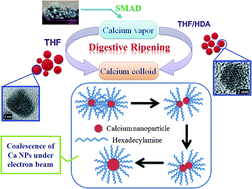The nanochemistry of calcium remains unexplored, which is largely due to the inaccessibility of calcium nanoparticles in an easy to handle form by conventional methods of synthesis as well as its highly reactive and pyrophoric nature. The synthesis of colloidal Ca nanoparticles by the solvated metal atom dispersion (SMAD) method is described. The as-prepared Ca–THF nanoparticles, which are polydisperse, undergo digestive ripening in the presence of a capping agent, hexadecyl amine (HDA) to afford highly monodisperse colloids consisting of 2–3 nm sized Ca–HDA nanoparticles. These are quite stable towards precipitation for long periods of time, thereby providing access to the study of the nanochemistry of Ca. Particles synthesized in this manner were characterized by UV-visible spectroscopy, high resolution electron microscopy, and powder X-ray diffraction methods. Under an electron beam, two adjacent Ca nanoparticles undergo coalescence to form a larger particle.
You have access to this article
 Please wait while we load your content...
Something went wrong. Try again?
Please wait while we load your content...
Something went wrong. Try again?


 Please wait while we load your content...
Please wait while we load your content...